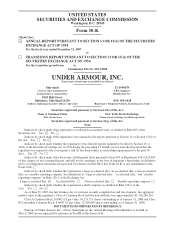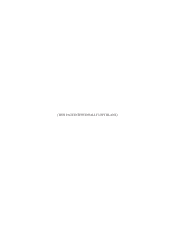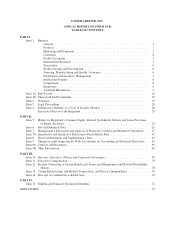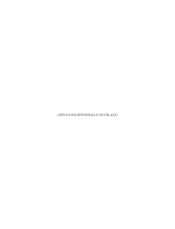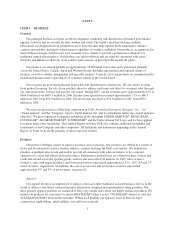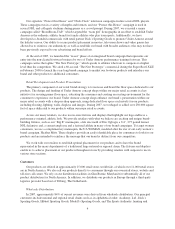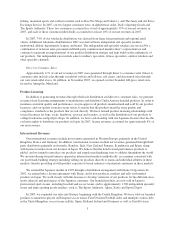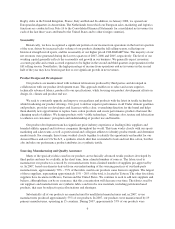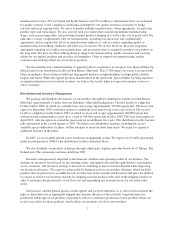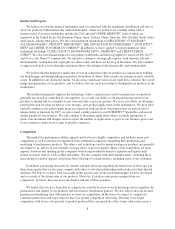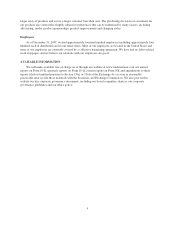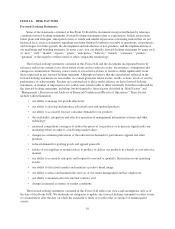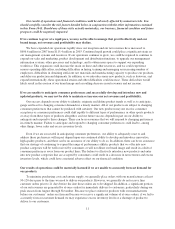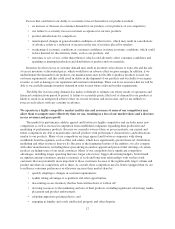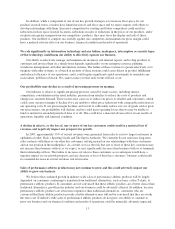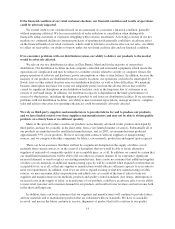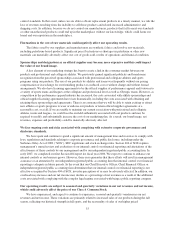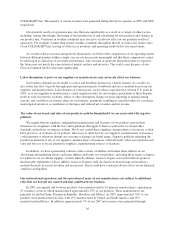Under Armour 2007 Annual Report Download - page 16
Download and view the complete annual report
Please find page 16 of the 2007 Under Armour annual report below. You can navigate through the pages in the report by either clicking on the pages listed below, or by using the keyword search tool below to find specific information within the annual report.Rugby clubs in the United Kingdom, France, Italy and Ireland. In addition, in January 2006, we opened our
European headquarters in Amsterdam, The Netherlands from which our European sales, marketing and logistics
functions are conducted (see Note 16 to the Consolidated Financial Statements for consolidated net revenues for
each of the last three years attributed to the United States and to other foreign countries).
Seasonality
Historically, we have recognized a significant portion of our income from operations in the last two quarters
of the year, driven by increased sales volume of our products during the fall selling season, reflecting our
historical strength in fall sports, and the seasonality of our higher priced COLDGEAR®line. The majority of our
net revenues were generated during the last two quarters of 2007, 2006 and 2005, respectively. The level of our
working capital generally reflects the seasonality and growth in our business. We generally expect inventory,
accounts payable and certain accrued expenses to be higher in the second and third quarters in preparation for the
fall selling season. Nonetheless, the high percentage of income from operations and net revenues in the second
half of the year may have been in part due to our significant growth in net revenues.
Product Design and Development
Our products are manufactured with technical fabrications produced by third parties and developed in
collaboration with our product development team. This approach enables us to select and create superior,
technically advanced fabrics, produced to our specifications, while focusing our product development efforts on
design, fit, climate and product end use.
We seek to constantly upgrade and improve our gearlines and products with the latest in textile technology
while broadening our product offerings. Our goal, to deliver superior performance in all Under Armour gearlines
and products, provides our developers and licensees with a clear, overarching direction for the brand and helps
them identify new opportunities to replace basic cotton products and create performance products that meet the
changing needs of athletes. We design products with “visible technology,” utilizing color, texture and fabrication
to enhance our customers’ perception and understanding of product use and benefits.
Our product development team has significant prior industry experience at leading fabric suppliers and
branded athletic apparel and footwear companies throughout the world. This team works closely with our sports
marketing and sales teams as well as professional and collegiate athletes to identify product trends and determine
market needs. For example, these teams worked closely together to identify the opportunity and market for our
Armour Fleece and our UA Tech-T, a synthetic stretch shirt that is intended to look and feel like cotton, but that
also includes our performance product attributes in a synthetic textile.
Sourcing, Manufacturing and Quality Assurance
Many of the specialty fabrics used in our products are technically advanced textile products developed by
third parties and may be available, in the short term, from a limited number of sources. The fabric used to
manufacture our products is sourced by our manufacturers from a limited number of suppliers pre-approved by
us. In 2007, based on estimates derived from our understanding of the sourcing practices of our third-party
manufacturers, approximately 70% – 75% of the fabric used in our products came from six suppliers. The largest
of those suppliers, representing approximately 15% – 20% of the total, is located in Taiwan. The other five fabric
suppliers have locations in Mexico, Taiwan and the United States. We continue to seek to add new suppliers and
believe, although there can be no assurance, that this concentration will decrease over time. The fabrics used by
our suppliers and manufacturers are synthetic fabrics and involve raw materials, including petroleum based
products, that may be subject to price fluctuations and shortages.
Substantially all of our products are manufactured by unaffiliated manufacturers and, in 2007, seven
manufacturers produced approximately 55% of our products. In 2007, our products were manufactured by 19
primary manufacturers, operating in 15 countries. During 2007, approximately 53% of our products were
6



